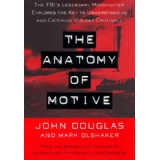I'm reading an awesome book called The Anatomy of Motive by John Douglas and Mark Olshaker.

The tag line on the front says, "The FBI's legendary Mindhunter explores the key to understanding and catching violent criminals." This book belongs to my husband (he's a professional crime analyst and studies criminology in his spare time), so I don't have to worry about returning it to the library any time soon. The thing I love about this book is the potential wealth of information for writers of all genres. Suspense, Mystery, Fantasy, even Amish Historical writers could find something fascinating in this book to help create realistic, believable antagonists. I think I'll take my time studying the book and passing along some of the information I find.
One of the first things that stuck out in the prologue was this brief but powerful statement: "Behavior reflects personality." This sums up why men like Douglas and Olshaker can use their vast experience in dealing with predators/violent offenders to come up with incredibly accurate profiles. "Even though every crime is unique, behavior fits into certain patterns." Picking out the significant pieces of those patterns leads to knowledge about what's going on with a crime scene and answers question of WHY did they do this unspeakable thing. Knowing WHY and HOW leads to WHO.
Writers can and should use this information when creating antagonists. While it's true that some people are just down-right evil and don't need any other motive beyond "I wanted to," most readers will demand a motive behind an act of violence.
When creating my antagonists, I work backward from the crime, which usually flows from the theme. For instance, one of my mysteries dealt with revenge as an act of love. It was basically the whole, "If I can't have you, no one can." I didn't want to stick too close to that stereotype, so I had to add a twist or two, but that's a topic for another post. Back to the point. In my story, creating an arsonist for the antagonist wouldn't work. Nor would a rapist, or a spree killer, or a serial killer. My bad girl wasn't a sociopath. Immediately, the parameters of my story dictated what kind of person she wasn't, letting me fill in the interesting parts about who she was. There's a lot more to it than that (her background, her mental health, her relationship with friends/family, her choice of weapon, her choice of dump site, her personality traits, etc.), but her personality was reflected in the crime scenes, which led my detective back to her.
This stuff is fascinating to me. I have a feeling I'll be posting good stuff from this book for quite a while. Any comments? Questions? Examples to share?
-Sonja


No comments:
Post a Comment